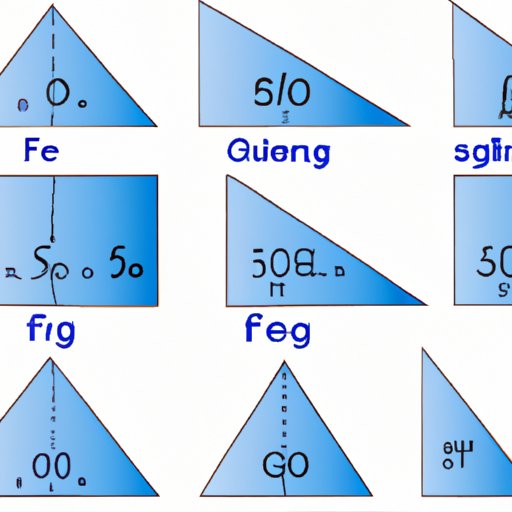Introduction
Have you ever stared at a triangle and wondered how to calculate its area? You are not alone. Many of us have difficulty with this seemingly complex problem, but it’s actually quite simple once you know how to do it. The area of a triangle is an important calculation used in many fields, including construction, surveying, and art. This article will provide a step-by-step guide to finding the area of a triangle, along with real-world examples, a historical perspective, interactive resources, and practice problems.
A Step-by-Step Guide
The formula for finding the area of a triangle is:
Area = 1/2 x base x height
Breaking this formula down into easy-to-follow steps:
1. Definition of Necessary Variables
The base is the longest side of the triangle, and the height is the perpendicular distance from the base to the opposite vertex. These two measurements will be necessary to use the formula.
2. Plug in Variables to Formula
Now that we have identified the base and height of the triangle, we can input them into the formula.
Area = 1/2 x base x height
3. Simplify and Solve Equation
Finally, all we have to do is simplify and solve the equation. For example, if the base of a triangle is 10 units and its height is 6 units:
Area = 1/2 x 10 x 6
Area = 30 square units
Using this formula and breaking it down into manageable parts, calculating the area of a triangle just became much simpler.
Real-World Examples
The area of a triangle is used in many professions and real-world scenarios. For example:
1. Builders/Architects
Builders and architects use the area of a triangle to calculate the amount of material needed to construct the roof of a house or a building. Once they have calculated the area of a triangular portion of the roof, they can determine how much shingles or other roofing material they will need.
2. Surveyors
Surveyors use the area of a triangle to calculate the size of plotted land or to create topographical maps. By identifying the dimensions of each triangular section of land, they can calculate total acreage.
3. Artists
Artists use the area of a triangle to create perspective in paintings or drawings. By understanding the basic principles of the area and its relationship to lines and angles, artists can create more realistic and aesthetically pleasing works.
A Historical Perspective
The formula we use today to calculate the area of a triangle can be traced back to the ancient Greeks.
1. Pythagoras
Pythagoras is perhaps the most famous Greek mathematician. He is credited with discovering the Pythagorean theorem, which is used to calculate the sides of a right triangle. This, in turn, led to the discovery of the formula for calculating the area of a triangle.
2. Euclid
Euclid is known as the “father of geometry.” He wrote the famous book “Elements,” which included many geometric principles and theorems, including the formula for calculating the area of a triangle.
Their discoveries and theorems paved the way for modern mathematics and the formulas we use today.
Interactive Resources
To assist readers in understanding the formula and how to use it, there are many interactive resources available online.
1. Tutorial Videos
YouTube has many tutorial videos that provide step-by-step instructions for calculating the area of a triangle. These videos can be helpful in understanding the process and in seeing the formula in action.
2. Interactive Quizzes
There are also many websites that offer interactive quizzes to test knowledge and reinforce learning. These quizzes can be helpful in assessing understanding and identifying areas that need improvement.
3. Sample Problems
Many educational websites provide sample problems for readers to practice the formula on their own. These problems range in difficulty level and can help build confidence and improve understanding.
Practice Problems
Now that you have a better understanding of the formula, it is time to put your knowledge to the test. Below are a few practice problems, ranging in difficulty level:
Easy:
Find the area of a triangle with a base of 6 units and a height of 4 units.
Medium:
Find the area of a triangle with a base of 12 units and a height of 8 units.
Difficult:
Find the area of a triangle with a base of 20 units and a height of 10 units.
Step-by-step solutions for each of these problems can be found online, or you can try to solve them on your own.
Conclusion
The area of a triangle is a simple yet important calculation used in many professions and real-world scenarios. By breaking down the formula into manageable steps and providing real-life examples and historical context, this article has hopefully made the process more accessible and understandable. With the use of interactive resources and practice problems, readers can continue to build their knowledge and confidence in utilizing this helpful method.
Remember: this formula may seem complex at first, but with practice and understanding, it is a relatively simple calculation that can be used in many aspects of life.
